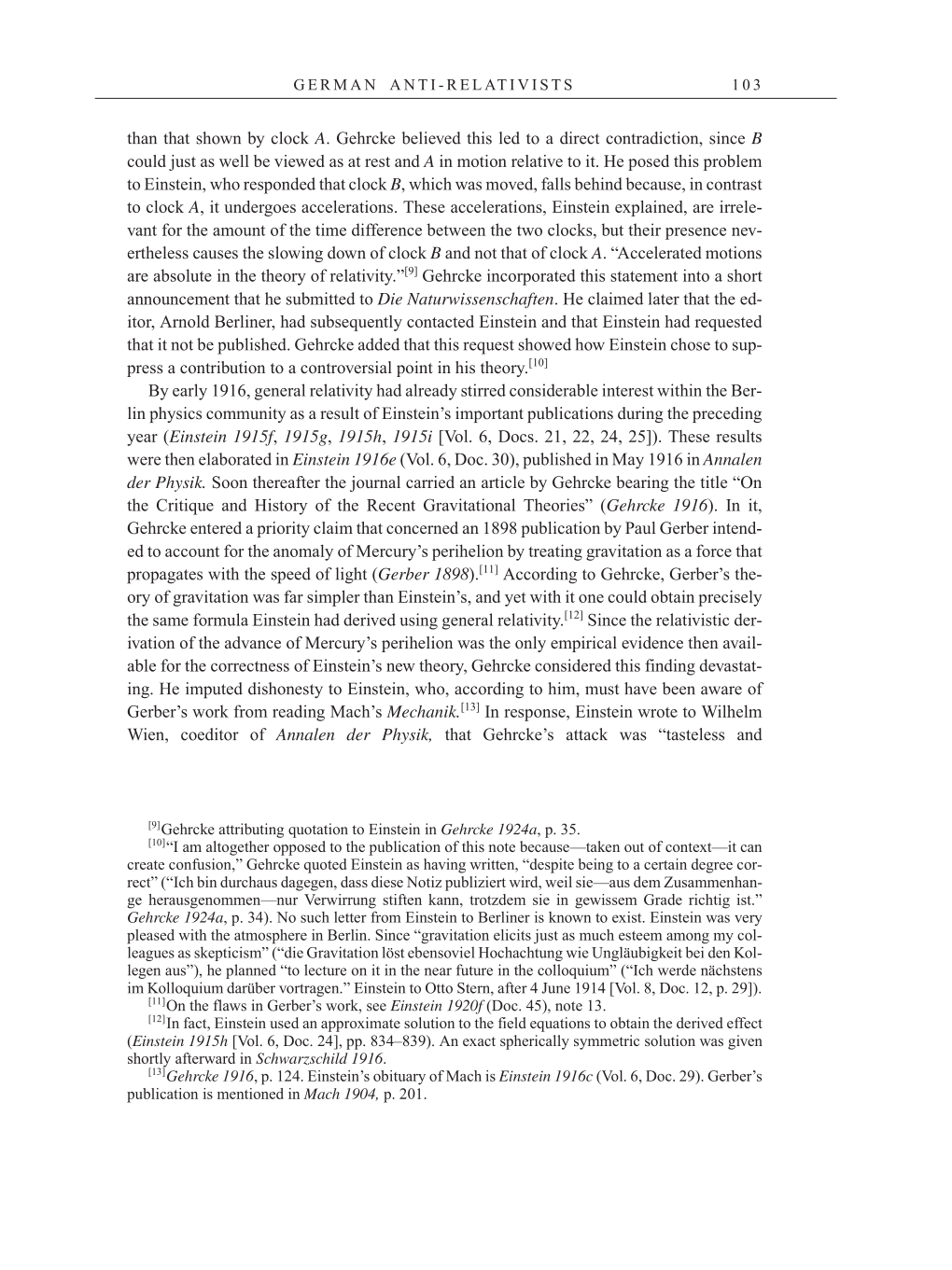G E R M A N A N T I - R E L AT I V I S T S 1 0 3
than that shown by clock A. Gehrcke believed this led to a direct contradiction, since B
could just as well be viewed as at rest and A in motion relative to it. He posed this problem
to Einstein, who responded that clock B, which was moved, falls behind because, in contrast
to clock A, it undergoes accelerations. These accelerations, Einstein explained, are irrele-
vant for the amount of the time difference between the two clocks, but their presence nev-
ertheless causes the slowing down of clock B and not that of clock A. “Accelerated motions
are absolute in the theory of
relativity.”[9]
Gehrcke incorporated this statement into a short
announcement that he submitted to Die Naturwissenschaften. He claimed later that the ed-
itor, Arnold Berliner, had subsequently contacted Einstein and that Einstein had requested
that it not be published. Gehrcke added that this request showed how Einstein chose to sup-
press a contribution to a controversial point in his
theory.[10]
By early 1916, general relativity had already stirred considerable interest within the Ber-
lin physics community as a result of Einstein’s important publications during the preceding
year (Einstein 1915f, 1915g, 1915h, 1915i [Vol. 6, Docs. 21, 22, 24, 25]). These results
were then elaborated in Einstein 1916e (Vol. 6, Doc. 30), published in May 1916 in Annalen
der Physik. Soon thereafter the journal carried an article by Gehrcke bearing the title “On
the Critique and History of the Recent Gravitational Theories” (Gehrcke 1916). In it,
Gehrcke entered a priority claim that concerned an 1898 publication by Paul Gerber intend-
ed to account for the anomaly of Mercury’s perihelion by treating gravitation as a force that
propagates with the speed of light (Gerber
1898).[11]
According to Gehrcke, Gerber’s the-
ory of gravitation was far simpler than Einstein’s, and yet with it one could obtain precisely
the same formula Einstein had derived using general
relativity.[12]
Since the relativistic der-
ivation of the advance of Mercury’s perihelion was the only empirical evidence then avail-
able for the correctness of Einstein’s new theory, Gehrcke considered this finding devastat-
ing. He imputed dishonesty to Einstein, who, according to him, must have been aware of
Gerber’s work from reading Mach’s
Mechanik.[13]
In response, Einstein wrote to Wilhelm
Wien, coeditor of Annalen der Physik, that Gehrcke’s attack was “tasteless and
[9]Gehrcke attributing quotation to Einstein in Gehrcke 1924a, p. 35.
[10]“I am altogether opposed to the publication of this note because—taken out of context—it can
create confusion,” Gehrcke quoted Einstein as having written, “despite being to a certain degree cor-
rect” (“Ich bin durchaus dagegen, dass diese Notiz publiziert wird, weil sie—aus dem Zusammenhan-
ge herausgenommen—nur Verwirrung stiften kann, trotzdem sie in gewissem Grade richtig ist.”
Gehrcke 1924a, p. 34). No such letter from Einstein to Berliner is known to exist. Einstein was very
pleased with the atmosphere in Berlin. Since “gravitation elicits just as much esteem among my col-
leagues as skepticism” (“die Gravitation löst ebensoviel Hochachtung wie Ungläubigkeit bei den Kol-
legen aus”), he planned “to lecture on it in the near future in the colloquium” (“Ich werde nächstens
im Kolloquium darüber vortragen.” Einstein to Otto Stern, after 4 June 1914 [Vol. 8, Doc. 12, p. 29]).
[11]On the flaws in Gerber’s work, see Einstein 1920f (Doc. 45), note 13.
[12]In fact, Einstein used an approximate solution to the field equations to obtain the derived effect
(Einstein 1915h [Vol. 6, Doc. 24], pp. 834–839). An exact spherically symmetric solution was given
shortly afterward in Schwarzschild 1916.
[13]Gehrcke 1916, p. 124. Einstein’s obituary of Mach is Einstein 1916c (Vol. 6, Doc. 29). Gerber’s
publication is mentioned in Mach 1904, p. 201.
